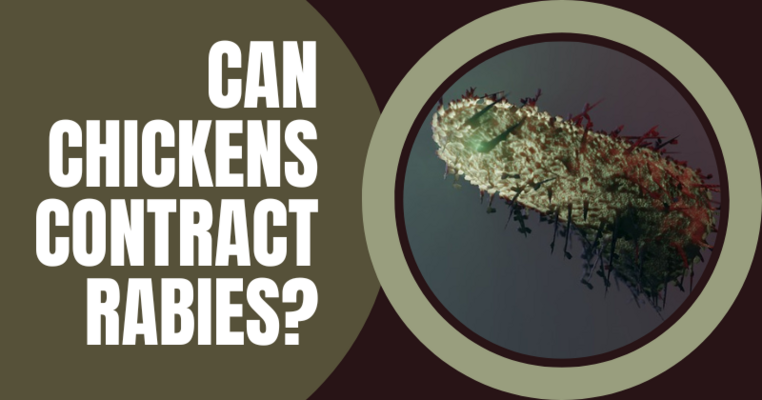Among the most dreadful diseases your livestock can suffer from is rabies. For now, it appears chickens cannot contract this infection. In any case, it is advisable to treat your poultry if they become infected by rabid animals.
The risk of rabies in chickens is generally low, however there has been one reported case in which rabies was found in a dead bird after being bitten by an infected dog. The incident took place in India, which is renowned for its high prevalence of rabies. It is safe to assume that chickens are not at risk of contracting rabies since it is one case.

Rabies is an easily preventable viral disease. Viruses that target the central nervous system can cause illness in the brain & ultimately death. Bats, foxes, raccoons, stray dogs, and skunks are the most common mammals to contract the virus.
Symptoms of rabies in humans are similar to those of the flu. It is common for victims to experience agitation, confusion, headaches, nausea, anxiety, vomiting, excessive salivation, hyperactivity, and a fever as the disease spreads. There is a possibility that the sick might have partial paralysis and hallucinations in severe cases.
Eventually, rabies will kill a person once they start showing symptoms. So a dog bite or any bite caused by a potentially rabid animal should always be treated.

Rabies can infect any mammal. Raccoons, foxes, skunks, and bats are the most common carriers of wild rabies. Infections can also spread to domestic mammals. Domestic animals most commonly infected with rabies are cats, cattle, and dogs.
It is primarily through bites that animals contract rabies. They can also become infected through open wounds or the mucous membranes of the mouth and nose.
An assessment of rabies exposure involves factors such as the location's prevalence of the disease, the animal's history of biting, and its health status.
The likelihood of an animal becoming rabid is low if it has been vaccinated. Rabies is also less likely to spread among cats, dogs, or ferrets kept in a confined environment.
You should vaccinate your family pets against rabies to prevent the spread of the disease. A simple way to reduce the risk of infection is to monitor your dog's movements and to keep cats & ferrets indoors.
Furthermore, spaying or neutering your pets can reduce the number of unwanted pets in the area. They might be unvaccinated and stray.
A final step should be to call animal control services in your area to remove all stray animals. There may be a problem with these animals' health or they may not be vaccinated.
As soon as it enters the brain, it causes neurologic damage, manifesting in symptoms such as partial paralysis, sleeplessness, excessive drooling, and unexplained fear. Eventually, a coma develops and the patient dies.

In the course of an attack, the rabies virus systematically deteriorates the nervous system until death is caused. Four phases are involved: the incubation stage, the prodromal stage, the acute neurologic stage, and the coma stage.
During an examination, the doctor will ask you which animal scratched or bit you and if it can be tested. Treatment will then be administered.
To prevent an outbreak of rabies, euthanize any pets or livestock showing symptoms of the disease.
The risk of rabies in chickens is generally low, however there has been one reported case in which rabies was found in a dead bird after being bitten by an infected dog. The incident took place in India, which is renowned for its high prevalence of rabies. It is safe to assume that chickens are not at risk of contracting rabies since it is one case.
What's Rabies?
Rabies is an easily preventable viral disease. Viruses that target the central nervous system can cause illness in the brain & ultimately death. Bats, foxes, raccoons, stray dogs, and skunks are the most common mammals to contract the virus.
Symptoms of rabies in humans are similar to those of the flu. It is common for victims to experience agitation, confusion, headaches, nausea, anxiety, vomiting, excessive salivation, hyperactivity, and a fever as the disease spreads. There is a possibility that the sick might have partial paralysis and hallucinations in severe cases.
Eventually, rabies will kill a person once they start showing symptoms. So a dog bite or any bite caused by a potentially rabid animal should always be treated.
How Come Chickens Can't Get Rabies?
Because chickens aren't mammals, they can't contract rabies. Mammals are the only creatures affected by rabies, as mentioned earlier.Are chickens capable of spreading Rabies?
Due to the fact that chickens do not contract rabies, they cannot spread it. If you handle a chicken bitten by a rabid animal, you have a low risk of contracting the disease.In what animals does Rabies occur?
Rabies can infect any mammal. Raccoons, foxes, skunks, and bats are the most common carriers of wild rabies. Infections can also spread to domestic mammals. Domestic animals most commonly infected with rabies are cats, cattle, and dogs.
It is primarily through bites that animals contract rabies. They can also become infected through open wounds or the mucous membranes of the mouth and nose.
An assessment of rabies exposure involves factors such as the location's prevalence of the disease, the animal's history of biting, and its health status.
The likelihood of an animal becoming rabid is low if it has been vaccinated. Rabies is also less likely to spread among cats, dogs, or ferrets kept in a confined environment.
You should vaccinate your family pets against rabies to prevent the spread of the disease. A simple way to reduce the risk of infection is to monitor your dog's movements and to keep cats & ferrets indoors.
Furthermore, spaying or neutering your pets can reduce the number of unwanted pets in the area. They might be unvaccinated and stray.
A final step should be to call animal control services in your area to remove all stray animals. There may be a problem with these animals' health or they may not be vaccinated.
In what ways do humans contract Rabies?
Rabies is transmitted to humans through the saliva of animals that are infected. Once you are infected with the virus, it moves slowly through the central nervous system.As soon as it enters the brain, it causes neurologic damage, manifesting in symptoms such as partial paralysis, sleeplessness, excessive drooling, and unexplained fear. Eventually, a coma develops and the patient dies.
Rabies prevalence
Worldwide, rabies is estimated to kill 60,000 people each year. Antarctica is the only continent where the disease does not exist. As a result of low vaccination rates in rural Africa & Asia, it is most prevalent there.Rabies Infection Progression
In the course of an attack, the rabies virus systematically deteriorates the nervous system until death is caused. Four phases are involved: the incubation stage, the prodromal stage, the acute neurologic stage, and the coma stage.
Incubation
Before rabies attacks the central nervous system, it spends weeks in the bloodstream. During this incubation period, victims do not display any symptoms.Prodromal Stage
During this phase, the virus enters the central nervous system from the blood. Symptoms of the flu are caused by your immune system launching defense measures. Between 2 - 10 days constitute the prodromal stage. It is impossible to treat rabies once it reaches this stage.Acute Neurologic Stage
When you are in the acute neurologic stage of the virus, the virus damages your brain & spinal cord. Patients become aggressive, delirious, and have seizures. Some develop partial paralysis, which may last for up to a month before a coma develops.Coma
During the late stages of rabies infection, many people become comatose. Death occurs after a few days.Conclusion
Vaccinating livestock and avoiding wild animals is the best way to prevent rabies. A person who has been bitten by a suspected rabid animal should seek treatment immediately since its symptoms don't become evident until the disease is untreatable.During an examination, the doctor will ask you which animal scratched or bit you and if it can be tested. Treatment will then be administered.
To prevent an outbreak of rabies, euthanize any pets or livestock showing symptoms of the disease.



